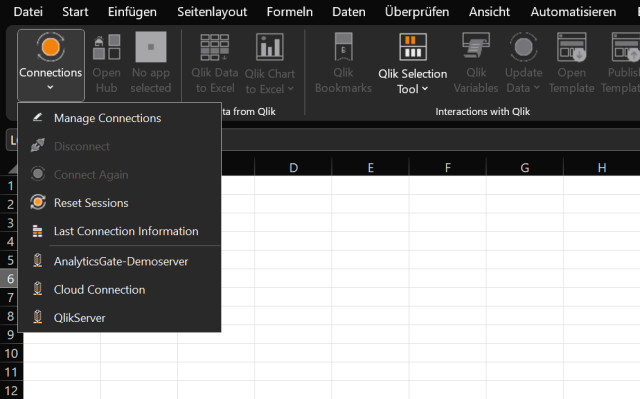Connection Settings
von Jan-Philipp Kalus (Netzhirsch)
Create a new Connection
The “Connection” portion of the AnalyticsGate ribbon allows you to create and manage the connections AnalyticsGate makes to your Qlik Sense environment(s).
- Click on the item “Connections” in the ribbon menu
- Click on the sub menu “Manage Connections”
- Fill the fields in the form with the appropriate values as described below
Connection Name
Enter a unique name for the connection.
Note:
Sometimes Qlik Sense is run on a server without a valid security certificate. Checking this box will ignore https://certificate errors that are encountered and proceed with the connection anyway. Unchecking the box will allow the https:// chain to remain intact and provides the highest security. The default setting is “checked”.
Connection Type
Depending on your Qlik Sense authorization strategy and which browser you are using, this parameter can be set to allow AnalyticsGate to work in any environment.
There are 5 different connection types available
- Qlik Sense Desktop. This setting is included in the default AnalyticsGate installation and points to the local machine using 127.0.0.1 as the IP address. If you do not require use of Qlik Sense Desktop as a data source, this connection can be deleted. It can be recreated if needed by creating a new connection using the following parameters: Type: Qlik Sense Desktop and Url: ws: //127.0.0.1:4848.
- Qlik Sense Server via currently logged in Windows user. Like Qlik Sense, the default behavior of AnalyticsGate uses Windows authentication which passes the credentials of the current Windows user to Qlik Sense. This approach supports Windows based single sign on strategies such as Active Directory.
- Qlik Sense Server via user name and password. This approach is used when you have different credentials for Qlik Sense from those for your local windows machine. This approach works similar to Qlik Sense Forms authentication and will prompt for Qlik Sense credentials each time you log on. This requires the use of UserDirectory\UserId syntax for the user name.
- Qlik Sense Server via authentication in the browser.This approach is used when you have different credentials for Qlik Sense than your local windows machine. This approach works similar to Qlik Sense Forms authentication and will prompt for Qlik Sense credentials each time you log on. This requires the use of UserDirectory\UserId syntax for the user name. This technique will attempt to connect with then local Windows credentials first and then, if not successful, open a new embedded browser window and prompt for credentials and pass them to Qlik Sense via the browser session cookie to login. Use this approach when your local Windows credentials are different from those used for Qlik or when connecting via a proxy server url, for example https://yourqlikserver/Development, or when using 3third-party authentication like Okta e. g. https://yourqlikserver/okta
- Qlik Cloud. Use this connection type when connecting to Qlik Sense Cloud.
Qlik Cloud
Enter the Url of your Qlik Sense cloud tenant, e. g. https://yourcompany.us.qlikcloud.com
The parameter “Session Cookie Header Name” should already be filled for this connection type. If not, use “-csrfToken” as the value.
You will need to have your Qlik Cloud administrator create an API Key for you or grant you the privilege to create your own.
If you have API Key creation privileges, from the Qlik Cloud Welcome Screen or the Hub, click on the initials icon on the top right of your screen then click Settings → Management → API Keys>Generate New Key.
At API key creation time, you will need to copy and paste it into a text file for later use or paste it directly into the AnalyticsGate API key parameter. After initial creation time you cannot access the key again and if you lose it, you will need to generate a new one.
Session cookie header name
AnalyticsGate supports defining connections that point to different virtual proxy servers in a distributed Qlik Sense environment.
A virtual proxy name that begins with X-Qlik-Session can be used by appending the name of the virtual proxy directly to the Url. https://your.qlikserver.com/development
If your virtual proxy has a header name that begins with anything other than “X-Qlik-Session” enter it in the “Session cookie header name” field as follows: “Otherheadername” Save your new connection by pressing the green check button.
To exit the AnalyticsGate property panel press the red “X” at the top right of the window.
Edit a connection
Once you have created connections using either technique you can edit them by doing the following:
- Click on the item “Connections” in the ribbon menu
- Click on the sub menu “Manage Connections”
- To edit any connection select the desired connection, press the “Pencil” icon and make your changes



